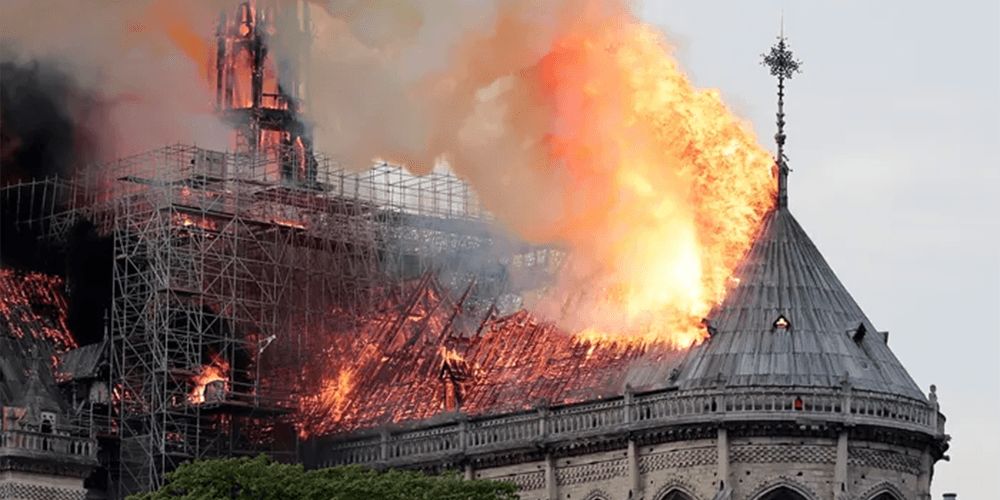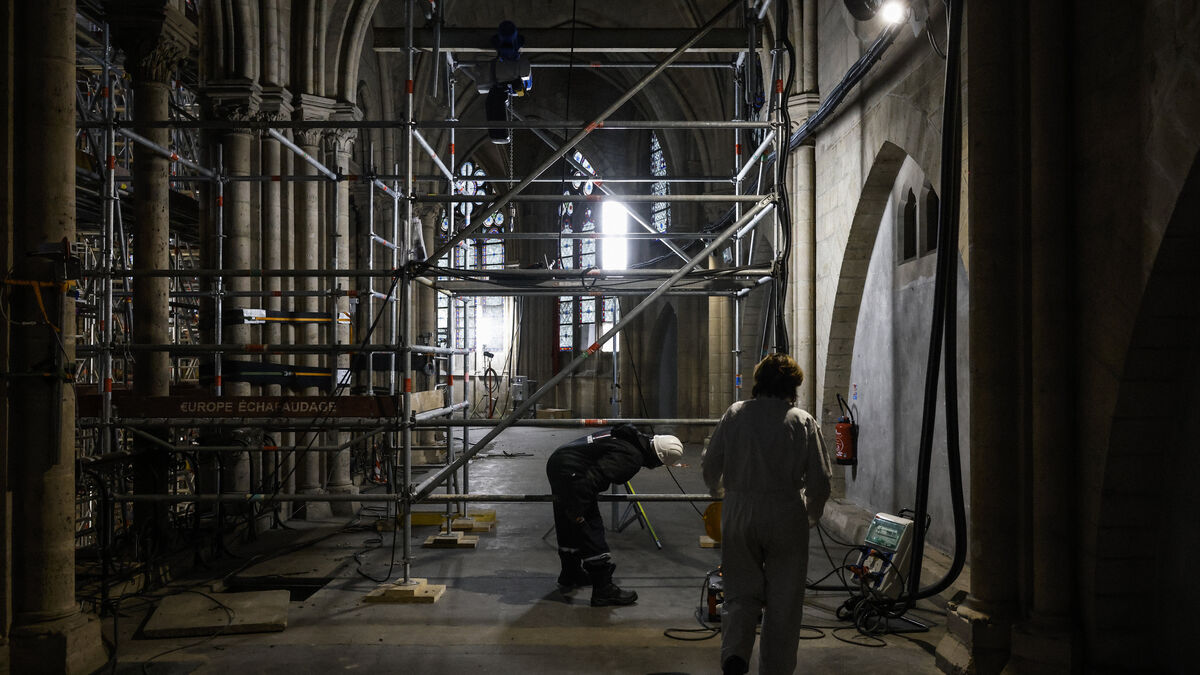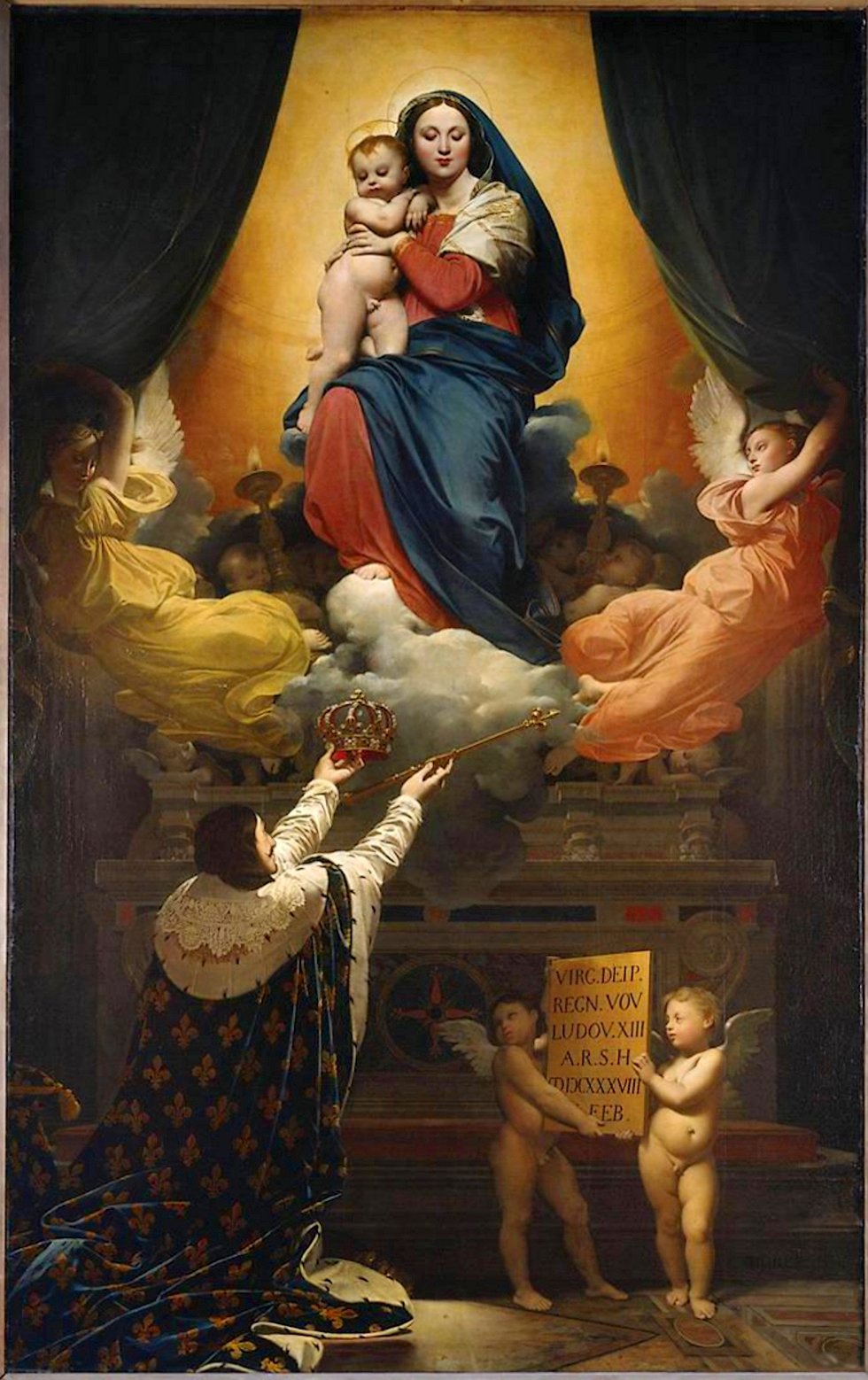Chantier de Notre-Dame de Paris : où en sommes-nous ? - Le Pèlerin: text=%E2%86%92%20En%20juin%202021%2C%20les,la%20reconstruction%20de%20la%20fl%C3%A8che.
Où en sommes-nous du chantier de Notre-Dame de Paris ?
Alors que les travaux de consolidation sont terminés et que l’Établissement public chargé de la restauration lance ses appels à candidature pour les entreprises, le point sur les étapes du chantier.
Par
Sophie Laurant
Mis à jour le 27 janvier 2022 à 6:23
Publié le 1 décembre 2021 à 6:33
FacebookTwitterPartager
5 commentaires
La bâche en toile a été remplacée par cette structure métallique qui protégera la cathédrale durant toute la période de restauration. © Stéphane Compoint pour Le Pèlerin
Travaux de sécurisation : terminés
Quarante-huit heures après l’incendie du 15 avril 2019, les travaux de sécurisation commencent dans l’urgence grâce à la mobilisation exceptionnelle des entreprises, emmenées par leur syndicat, le GMH, en lien avec le ministère de la Culture. De nombreuses tâches sont menées en parallèle :
→ Les pignons nord et ouest ont été étayés et leurs statues, endommagées par la chaleur, mises à l’abri.
→ Les grandes baies vitrées supérieures du chevet et des tribunes ont été déposées. Il faut permettre aux ouvriers de passer et de poser de longues poutres et autres éléments vers l’intérieur de la cathédrale : il est urgent de stabiliser les murs poussés vers l’intérieur par l’absence de toiture.
→ Des cintres en bois viennent soutenir les arcs-boutants, à l’extérieur de la cathédrale.
→ Très vite aussi, l’évacuation des décombres de l’incendie s’impose. Tout est stocké, trié répertorié, sous de grands barnums installés sur le parvis.
>>> À lire aussi sur Lepelerin :
Exclusif et spectaculaire : Notre-Dame de Paris en 360°
Phase de consolidation : terminée
Avec la création, fin novembre 2019, de l’
Établissement public, dirigé par le général Jean-Louis Georgelin, on glisse peu à peu vers une phase de « consolidation » et on prépare déjà l’avenir : le chantier de restauration proprement dit :
→ Dès le début, des scientifiques de toutes disciplines, venus principalement du CNRS, du Laboratoire de restauration des Monuments historiques, de l’université… entrent en action sous les barnums et dans l’édifice pour étudier chaque vestige, faire des relevés, des photographies, apporter leurs études et analyses préalables à la connaissance des architectes en chef du chantier sous la houlette de Philippe Villeneuve. Il s’agit de « documenter leur diagnostic » puis de leur permettre de prendre des décisions concernant les différentes options de restauration.
→ Une base de chantier commence à être construite au chevet de la cathédrale : il faut des bureaux, des douches et des vestiaires dans les sas indispensables entre cette zone et le chantier pollué.
→ Un nettoyage progressif des surfaces recouvertes de poussière de plomb provenant de la fonte des plaques de la toiture, est lancé. Mais il est lent et difficile. Aussi tous les ouvriers doivent se protéger par des masques, gants et combinaisons, contre cette pollution permanente du site, et se nettoyer intégralement avant toute sortie de la « zone sale » du chantier.
→ Sous les voûtes, des filets sont posés pour éviter les chutes de pierre. Les piliers sont coffrés pour éviter les chocs avec les engins de chantiers. Lustres et statues sont emballés et évacués.
→ À l’automne 2020, les tuyaux de l’orgue sont démontés à leur tour pour être dépoussiérés du plomb par des facteurs d’orgue. Mais l’énorme buffet et les plus gros tuyaux restent en place.
→ Un « parapluie » est progressivement posé au-dessus des voûtes : il permet de mettre « hors d’eau et hors d’air» la majeure partie des voûtes, sauf au niveau du plus grand des trois « trou» percés par la chute de la flèche, car la présence de l’ancien échafaudage gêne.
→ Un « faux plafond » est installé sous le parapluie. Les cordistes peuvent se suspendre à ce toit provisoire pour entamer manuellement le déblayage des décombres de la charpente qui pèsent sur l’extrados (la partie extérieure) des voutes.
→ En parallèle, et grâce à l’arrivée en décembre 2019 d’une gigantesque grue, l’échafaudage de 250 tonnes qui ceinturait la flèche disparue, chauffé et tordu par l’incendie, commence à être démonté tuyau par tuyau par les cordistes à partir de juin 2020. Ce démontage s’achèvera le 24 novembre 2020.
→ Les voûtes fragilisées sont enduites d’une filasse de chaux afin que la pierre ne s’effrite plus.
→ Deux chapelles latérales sont isolées du reste de la cathédrale et entament déjà leur remise à neuf : un nettoyage fin, une restauration des petites lacunes de peinture… Il s’agit de « tester » différentes méthodes et de comparer les résultats, le temps nécessaire, afin de pouvoir par la suite, choisir comment seront restaurées toutes les autres chapelles.
→ Des cintres en bois, fabriqués sur mesure, sont posés sous toutes les voûtes fragilisées pour préparer leur restauration.
→ En mars 2021, l’abattage des premiers chênes, ceux nécessaires à la reconstitution de la flèche, ont été abattus. Ils seront prêts d’ici dix-huit mois.
>>> À lire aussi sur Lepelerin :
Christian Viguerie offre des chênes à Notre-Dame de Paris
→ À l’intérieur, la cathédrale est entièrement tapissée d’échafaudages. A différents niveaux, des planchers permettent de travailler à hauteur d’homme, sans être suspendus à des harnais. Le plus haut est installé juste sous les voûtes, sur toute la longueur de l’édifice et de son transept.
→ En juin 2021, les immenses statues des apôtres, qui ornaient la flèche, rescapées de l’incendie, sont revenues restaurées à la Cité de l’architecture et du patrimoine où elles seront exposées au public jusqu’à la reconstruction de la flèche.
>>> À lire aussi sur Lepelerin :
La nouvelle vie des apôtres rescapés de l’incendie de Notre-Dame
→ Avec le dégagement des vestiges de la flèche retrouvés sur les voûtes, s’achève à l’été 2021 le déblaiement des gravats, stockés désormais dans des réserves.
→ Au-dessus des voûtes, le parapluie de plastique est remplacé par un toit provisoire en tôle. Une partie coulissante sur rail permet de fermer le « trou » pour éviter l’humidité mais de maintenir une ouverture ponctuelle pour passer des éléments et, plus tard pour faciliter la reconstruction de la flèche.
Phase de restauration : en cours et à venir
Lors des journées du Patrimoine, en septembre 2021, le général Georgelin annonce officiellement l’entrée dans la phase de restauration de Notre-Dame de Paris. Celle-ci se traduit par un appel à candidature pour les entreprises qui vont :
→ consolider les voûtes ;
→ reconstruire la charpente et la toiture ;
→ participer au nettoyage ;
→ et entreprendre la restauration complète de l’intérieur de la cathédrale et de son mobilier.
Article rédigé par
Sophie Laurant, en collaboration avec
Stéphane Compoint
>>> À lire aussi sur Lepelerin :
Notre-Dame, le chantier de la renaissance
Where are we on the Notre-Dame de Paris project?
As the consolidation work is completed and the Public Institution in charge of the restoration launches its calls for tenders for companies, here is an update on the stages of the project.
By Sophie Laurant
Updated on January 27, 2022 at 6:23 am
Published on December 1, 2021 at 6:33 am
FacebookTwitterShare
5 comments
Work on Notre-Dame de Paris
The canvas tarp has been replaced by this metal structure that will protect the cathedral during the restoration period. Stéphane Compoint for Le Pèlerin
Security work: completed
Forty-eight hours after the fire of April 15, 2019, the security work began in a hurry thanks to the exceptional mobilization of companies, led by their union, the GMH, in conjunction with the Ministry of Culture. Many tasks are being carried out in parallel:
→ The north and west gables were shored up and their statues, damaged by the heat, put under cover.
→ The large upper windows of the chevet and the tribunes have been removed. Workers must be allowed to pass through and lay long beams and other elements toward the interior of the cathedral: it is urgent to stabilize the walls pushed inward by the lack of a roof.
→ Wooden arches are used to support the buttresses on the outside of the cathedral.
→ Very quickly, too, the evacuation of the fire rubble becomes necessary. Everything was stored, sorted and catalogued, under large tarpaulins installed on the square.
>>> Also read on Lepelerin: Exclusive and spectacular: Notre-Dame de Paris in 360°.
Consolidation phase: completed
With the creation, at the end of November 2019, of the Public Establishment, headed by General Jean-Louis Georgelin, we are gradually slipping into a "consolidation" phase and are already preparing for the future: the actual restoration work:
→ From the beginning, scientists of all disciplines, mainly from the CNRS, the Laboratory of Restoration of Historic Monuments, the university ... enter into action under the barnums and in the building to study each vestige, make surveys, photographs, bring their studies and preliminary analysis to the knowledge of the architects in chief of the site under the leadership of Philippe Villeneuve. The aim is to "document their diagnosis" and then to enable them to make decisions regarding the various restoration options.
→ A worksite base is beginning to be built at the cathedral's bedside: offices, showers, and changing rooms are needed in the indispensable airlocks between this area and the polluted worksite.
→ A gradual cleaning of the surfaces covered with lead dust from the melting of the roof plates is initiated. But it is slow and difficult. Also all the workers must protect themselves with masks, gloves and overalls, against this permanent pollution of the site, and clean themselves completely before any exit from the "dirty zone" of the building site.
→ Under the vaults, nets are laid to prevent stone from falling. The pillars are cased to avoid shocks with the construction machinery. Chandeliers and statues are packed and removed.
→ In the fall of 2020, the organ pipes are dismantled in turn to be dusted of lead by organ builders. But the huge case and larger pipes remain in place.
→ An "umbrella" is progressively installed above the vaults: it allows to put "out of water and out of air" the major part of the vaults, except at the level of the biggest of the three "holes" pierced by the fall of the spire, because the presence of the old scaffolding hinders.
→ A "false ceiling" is installed under the umbrella. The rope access technicians can hang from this temporary roof to manually begin clearing the rubble from the framework that is weighing down the extrados (the outer part) of the vaults.
→ In parallel, and thanks to the arrival in December 2019 of a gigantic crane, the 250-ton scaffolding that girdled the disappeared spire, heated and twisted by the fire, begins to be dismantled pipe by pipe by the rope access technicians from June 2020. This dismantling will be completed on November 24, 2020.
→ The weakened vaults are coated with a lime filasse so that the stone no longer crumbles.
→ Two side chapels are isolated from the rest of the cathedral and are already beginning their refurbishment: a fine cleaning, a restoration of the small gaps in the paint... It is a matter of "testing" different methods and comparing the results, the time needed, so that later on, it will be possible to choose how all the other chapels will be restored.
→ Custom-made wooden hangers are placed under all the weakened vaults to prepare for their restoration.
→ In March 2021, the first oak trees, those needed for the reconstruction of the spire, were felled. They will be ready by di
In March 2021, the first oaks, those needed to rebuild the spire, were felled. They will be ready in eighteen months.
>>> Also read on Lepelerin: Christian Viguerie offers oaks to Notre-Dame de Paris
→ Inside, the cathedral is entirely lined with scaffolding. At different levels, floors allow work to be done at man's height, without being suspended from harnesses. The highest is installed just under the vaults, along the entire length of the building and its transept.
→ In June 2021, the huge statues of the apostles, which adorned the spire, rescued from the fire, returned restored to the Cité de l'architecture et du patrimoine where they will be on public display until the spire is rebuilt.
>>> Also read on Lepelerin: The new life of the apostles who survived the Notre-Dame fire
→ With the clearing of the remains of the spire found on the vaults, the clearing of the rubble, now stored in storerooms, will be completed in summer 2021.
→ Above the vaults, the plastic umbrella is being replaced by a temporary sheet metal roof. A sliding part on a rail makes it possible to close the "hole" to avoid humidity but to maintain a punctual opening to pass elements and, later to facilitate the reconstruction of the spire.
Restoration phase: in progress and to come
During the Heritage Days, in September 2021, General Georgelin officially announced the entry into the restoration phase of Notre-Dame de Paris. This is reflected in a call for applications for companies that will:
→ consolidate the vaults ;
→ rebuild the framework and the roof; → participate in the cleaning
→ participate in the cleaning ;
→ and undertake the complete restoration of the interior of the cathedral and its furniture.
Article written by Sophie Laurant, in collaboration with Stéphane Compoint
>>> Also read on Lepelerin: Notre-Dame, the site of the rebirth
Notre-Dame de Paris

 www.sott.net
www.sott.net








